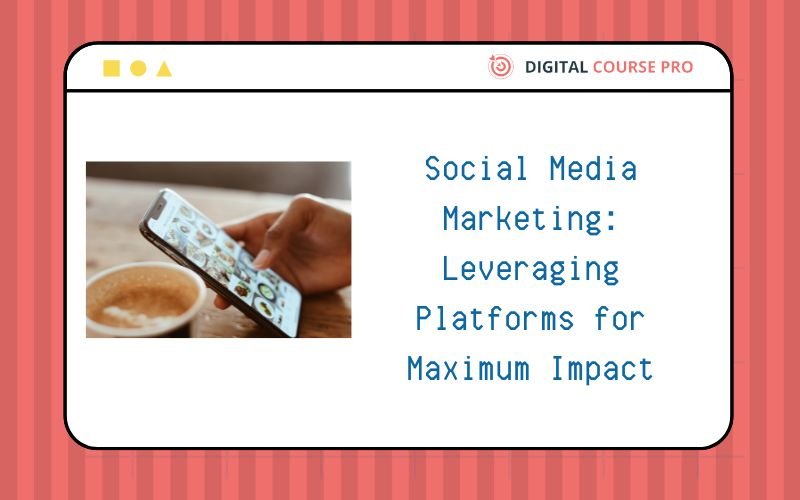Social Media Marketing: Leveraging Platforms for Maximum Impact is a pivotal module within the “10 Steps to Mastering Simply Passive Digital Marketing Course.” This segment explores the strategies and tools essential for harnessing the power of social media platforms effectively. Whether you’re new to digital marketing or seeking to refine your social media tactics, this course provides a comprehensive roadmap to building and executing successful social media campaigns. Discover how to engage with your audience, optimize content for different platforms, and utilize analytics to drive meaningful results. Dive into our detailed page to start mastering social media marketing and elevate your digital strategy today.
Choosing the Right Platforms
- Understanding Platform Demographics:
Research and understand the demographics and user behavior on different social media platforms:
- Facebook: Broad demographic with a focus on older demographics, ideal for B2C and B2B businesses.
- Instagram: Popular among younger demographics (under 35), highly visual content, suitable for lifestyle, fashion, and creative industries.
- Twitter: Real-time updates, news, and conversations, suitable for businesses with timely content and customer service needs.
- LinkedIn: Professional networking platform, ideal for B2B businesses, career-focused content, and industry thought leadership.
- TikTok: Short-form video platform popular among Gen Z and millennials, ideal for brands with creative and engaging video content.
- Aligning with Business Objectives:
Choose platforms that align with your business goals, target audience preferences, and content strategy. Prioritize platforms where your audience is most active and where your content can make the most impact.
Creating a Social Media Strategy
- Setting Clear Goals:
Define specific and measurable goals for your social media efforts, such as increasing brand awareness, driving website traffic, generating leads, or improving customer engagement. Align goals with overall business objectives to ensure consistency and relevance. - Target Audience Identification:
Develop detailed buyer personas to understand your target audience’s demographics, interests, pain points, and online behavior. Use social media analytics and insights to refine audience targeting and content strategy. - Content Plan Development:
Outline a content calendar with themes, topics, content types (images, videos, blog posts, infographics), and posting schedules. Tailor content to each platform’s unique features and audience expectations while maintaining brand voice and consistency. - Metrics for Success:
Determine key performance indicators (KPIs) to measure social media success, such as engagement rate, reach, clicks, conversions, and ROI. Use analytics tools to track KPIs and adjust strategies based on performance data.
Content Creation and Curation
- Creating Engaging Content:
Produce high-quality content that educates, entertains, or inspires your audience. Use storytelling, visual elements, and interactive formats to capture attention and encourage sharing. - Curating Relevant Content:
Share curated content from industry leaders, influencers, and reputable sources that align with your brand values and interests your audience. Curated content enhances credibility, provides diverse perspectives, and keeps your feed dynamic.
Building a Community
- Engagement Strategies:
Foster community engagement by responding to comments, messages, and mentions promptly. Encourage discussions, ask questions, and solicit feedback to create a dialogue with your audience. - Hosting Live Events and Interactive Campaigns:
Host live Q&A sessions, webinars, virtual events, and contests to interact directly with your audience. Live content boosts engagement, increases reach, and builds authenticity and trust.
Utilizing Visuals and Multimedia
- Visual Content Strategy:
Use high-quality images, videos, infographics, and GIFs to enhance visual appeal and convey messages effectively. Tailor visuals to platform specifications and audience preferences for optimal engagement. - Video Content:
Create engaging video content such as tutorials, behind-the-scenes glimpses, product demonstrations, and customer testimonials. Video content often receives higher engagement rates and shares on social media.
Hashtags and Trends
- Hashtag Strategy:
Research relevant hashtags that resonate with your target audience and industry trends. Use hashtags strategically to increase discoverability, join conversations, and amplify the reach of your posts. - Trending Topics:
Monitor trending topics, news, and viral content relevant to your industry. Incorporate trending topics into your content strategy to capitalize on current events and increase visibility.
Social Media Advertising
- Paid Advertising Options:
Utilize social media advertising platforms (e.g., Facebook Ads Manager, Instagram Ads, LinkedIn Ads) to create targeted ad campaigns. Define audience segments based on demographics, interests, and behaviors to reach specific audience groups. - Ad Creation and Optimization:
Design visually compelling ads with clear calls-to-action (CTAs) and compelling copy. A/B test ad variations to optimize performance and maximize ROI. Monitor ad metrics (impressions, clicks, conversions) and adjust targeting and budgeting strategies as needed.
Analytics and Performance Tracking
- Implementing Analytics Tools:
Use social media analytics tools (e.g., native platform analytics, Sprout Social, Hootsuite Analytics) to track key metrics and performance indicators. Measure engagement, reach, conversion rates, and customer sentiment to gauge the effectiveness of your social media efforts. - Data-Driven Decision Making:
Analyze performance data to identify trends, insights, and opportunities for improvement. Adjust content strategies, targeting parameters, and ad budgets based on analytics insights to optimize campaign performance and achieve business goals.
Staying Up-to-Date
- Monitoring Social Media Trends:
Stay informed about evolving social media trends, platform updates, algorithm changes, and best practices. Follow industry news, attend webinars, and participate in online communities to stay ahead of the curve. - Adapting Strategies:
Continuously iterate and adapt your social media strategies based on emerging trends, audience feedback, and performance data. Experiment with new content formats, engagement tactics, and platform features to maintain relevance and effectiveness.
By leveraging these strategies and techniques, businesses can effectively leverage social media platforms to enhance brand visibility, engage with their target audience, drive traffic, and achieve their marketing objectives.





